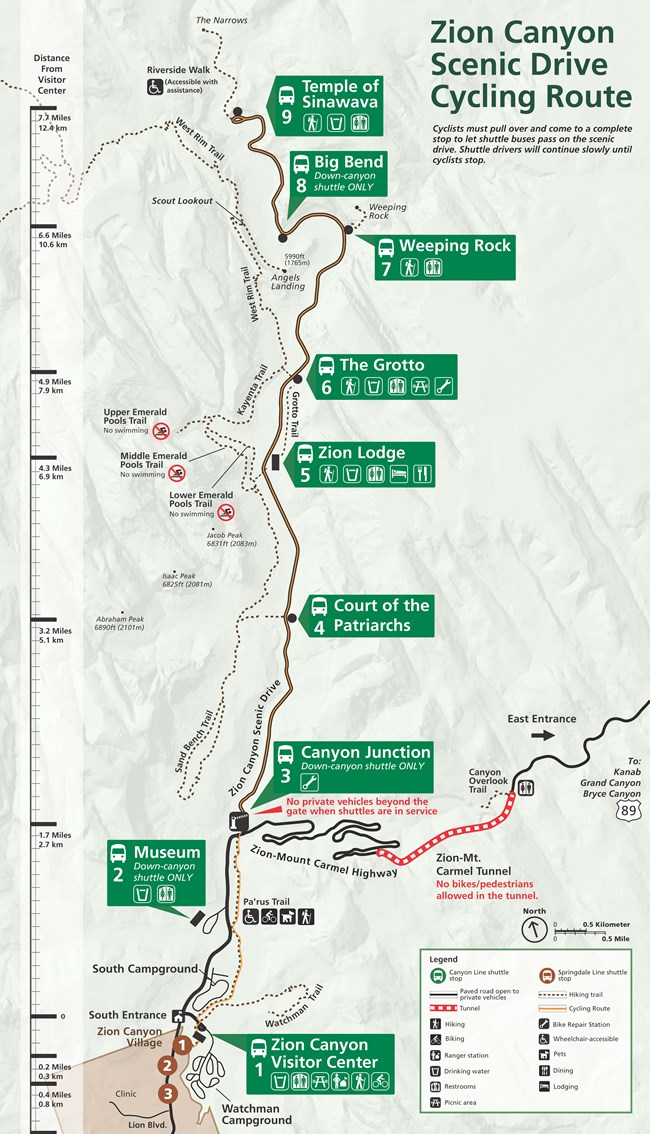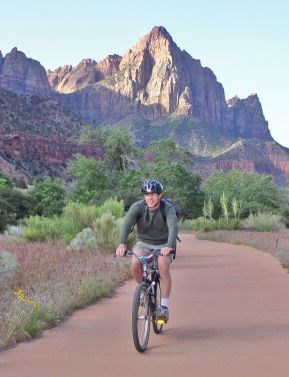
Riding your bike can be a great way to experience Zion National Park. Here are a few things to keep in mind if you decide to ride in the park. General Rules
Getting AroundThe bicycle entrance to Zion National Park is in Springdale next to the Zion Outfitter and the Zion Brew Pub. You’ll cross a small bridge with the Zion National Park River/Pedestrian Entrance fee station. The path will lead into the parking lot of the Zion Canyon Visitor Center. Please walk your bike through the Visitor Center Plaza. E-BikesClass 1 pedal-assist E-bikes are allowed in the same locations as bicycles and must follow all of the same rules. A Class 1 E-bike is defined as an electric bicycle equipped with a motor that provides assistance only when the rider is pedaling and that ceases to provide assistance when the bike reaches the speed of 20 miles per hour. Where to goBicycles are allowed in specific areas of Zion National Park. Read here to learn more about specific areas where you can cycle and what to expect if you do. 
Pa'rus TrailThe Pa'rus Trail is a multi-use path with foot and bike traffic, so slow down and please be considerate of other visitors. The Pa'rus Trail begins at the Zion Canyon Visitor Center and can take you to the Zion Canyon Scenic Drive without the need to ride on UT-9 (the Zion-Mt Carmel Highway).
Zion Canyon Scenic DriveThe Zion Canyon Scenic Drive is a well trafficked road for shuttles, NPS staff, and lodge visitors. Bikes must yield to oncoming traffic.
All Other Park Roads
A. The bicycle and pedestrian entrance is in Springdale next to the Zion Outfitter and the Zion Brew Pub. You’ll cross a small bridge with a fee station which will lead into the parking lot of the Zion Canyon Visitor Center. Please walk your bike through the Visitor Center plaza.
A. The fee is $20.00 per person which is good for seven days in Zion National Park. You can also use a valid park pass.
A. There are bicycle racks at the Zion Canyon Visitor Center and each shuttle stop along the Zion Canyon Scenic Drive.
A. The best places to bike are the Pa'rus Trail from the Visitor Center to Canyon Junction. Bicycles are not allowed on trails other than the Pa'rus
A. The Pa'rus Trail meanders along the Virgin river between the Zion Canyon Visitor Center and the Canyon Junction. It is a paved trail shared with pedestrians and leashed pets. Always be careful when passing people and dogs.
A. The trail is 1.75 miles from end to end. Please do not bike fast. There are lots of turns, bridges, blind corners and wildlife on the trail. Pedestrians have the right-of-way on this trail and cyclists must warn pedestrians before passing, either verbally ("passing on your left") or with a bell or horn. If pedestrians do not move out of the way, then stop until you can safely pass them. When the weather is damp the four bridges on the Pa'rus Trail may be slippery.
A. Riding your bicycle on the Zion Canyon Scenic Drive is an enjoyable option that can help you skip the shuttle and experience a more intimate visit with the canyon. A few things to keep in mind:
A. Effective August 30, 2019, Class 1 pedal-assist e-bikes are allowed in the same locations as regular bicycles and must follow all of the same rules. E-bikes will not fit on the shuttles bike rack, so please plan to ride the Zion Canyon Scenic Drive both ways.
Pedal Assist e-bikes: The term “pedal-assist e-bike” means a bicycle that contains an electric motor that provides supplemental power to move the bicycle. In order to be considered a pedal-assist e-bike, the electric motor must supply less than 50% of the power and must not be operable unless the rider is pedaling. Class 1 e-bikes cease to provide assistance when the bicycle reaches the speed of 20 miles per hour. A. Yes, bicycles are allowed on all paved roads, but other roads in the park have lots of vehicle traffic.
A: The Zion-Mount Carmel Tunnel was completed in 1930 with narrow lanes and no shoulder for cyclists to avoid vehicles. There are no lights within the historic 1.1-mile-long tunnel and several areas are completely dark. Numerous accidents and collisions have occurred within the tunnel due to the narrow and dark conditions. Please plan ahead to have a vehicle transport you and your bicycle through the tunnel.
A. Bicyclists should be careful when pulling off the road because of the presence of thorny plants which can cause flat tires. Carrying a flat kit with you, consisting of a spare tube, bike lever, and the tools necessary to remove your bicycles wheel, can help you out in a pinch!
|
Last updated: July 8, 2024
